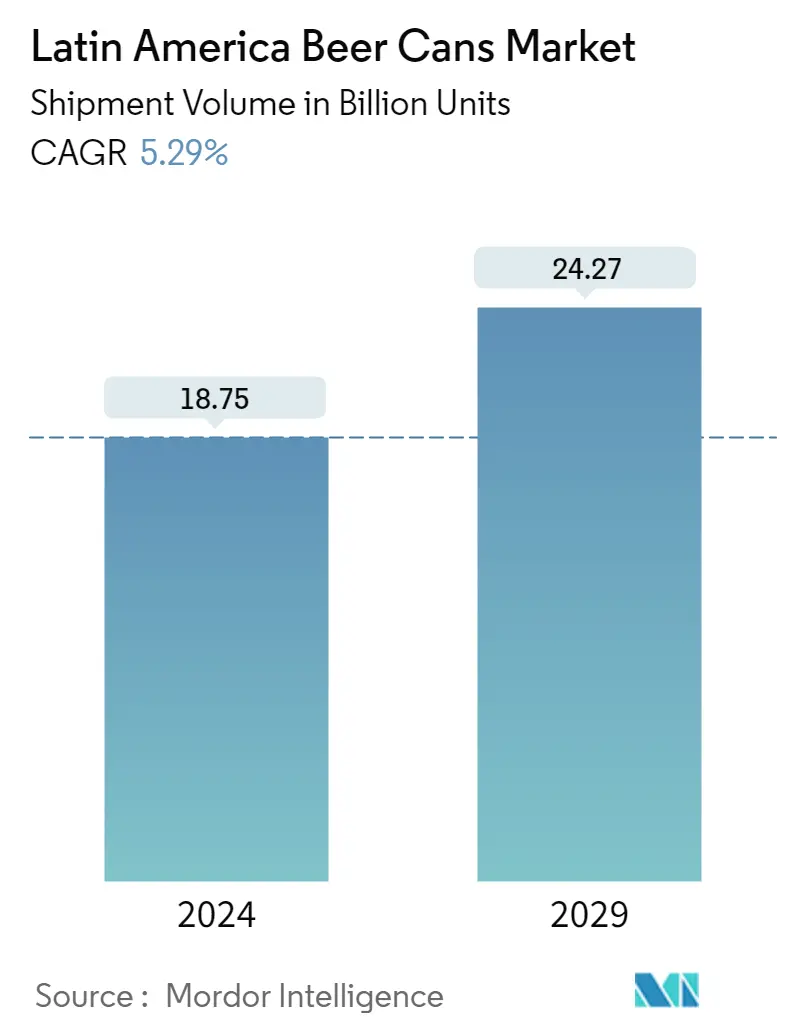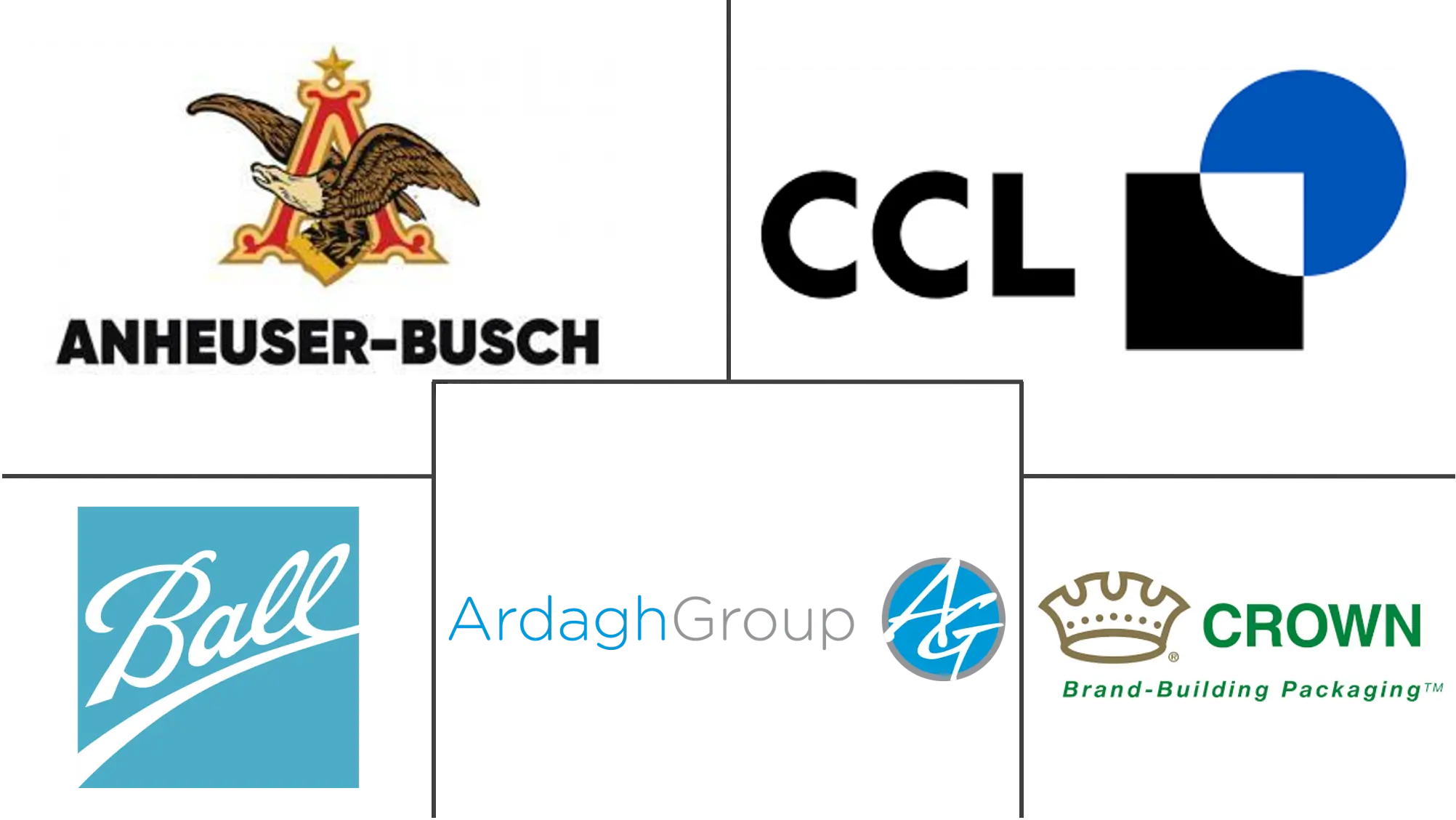Market Size of Latin America Beer Cans Industry

| Study Period | 2019 - 2029 |
| Base Year For Estimation | 2023 |
| Forecast Data Period | 2024 - 2029 |
| Historical Data Period | 2019 - 2022 |
| CAGR (2024 - 2029) | 5.29 % |
| Market Concentration | High |
Major Players
*Disclaimer: Major Players sorted in no particular order |
Latin America Beer Cans Market Analysis
The Latin America Beer Cans Market size in terms of shipment volume is expected to grow from 18.75 Billion units in 2024 to 24.27 Billion units by 2029, at a CAGR of 5.29% during the forecast period (2024-2029).
Latin America offers a massive opportunity for the growth of the market studied, as there is high alcohol consumption, and the region accounts for 18% of the beer consumption globally.
- The adoption of sustainability with environmental measures is expected to drive the market. Cans are permitted in many places where bottles are typically not allowed, such as beaches, pools, parks, campgrounds, ballparks, golf courses, boats, etc. Cans are 100-percent recyclable with other benefits such as much lighter than bottles, requiring less fuel to ship them, whether empty or filled, is an added advantage to it. An empty 12-ounce bottle weighs about 7 ounces, whereas an empty can weighs only about a half-ounce.
- The government in Brazil is playing a significant role in boosting local beer manufacturing. For instance, the Communist party government collaborated with AmBev, the local subsidiary, and AB InBev to launch Magnífica, a beer that is both sustainable and affordable.
- Further, the growing environmental concern in Mexico is forcing beer companies to adopt plastic-free cans. The brewer of Mexican beer, Corona, introduced a new can that does not use plastic ring carriers. The stackable cans are called Fit Packs and use zero plastic to screw together up to 10 cans in a stack.
- However, the preference of consumers for wine might act as a challenge to the market due to the increasing affordability of wine and liquor products, and this shift is expected to continue, making more consumers shift towards these commodities. For instance, Argentina has the largest consumption of wine in Latin America, and as of 2018, the consumption rate was 8.4 million hectoliters (source Food and Agriculture Organization).
- Further, due to the COVID-19 pandemic, the consumption rate had fallen down due to the lockdown period. Mexico has run out of beer due to factory shut down in pandemic. Beer stocks were depleted within a month, and in some areas, the prices of what was left doubled. With factory shutdown during the initial phase of lockdown, the demand for metal cans decreased drastically. Also, the Mexican company Corona beer and Heineken has been temporarily halted production as the country declared a health emergency over the pandemic. The Mexican government ordered a suspension of all non-essential activities currently.
- Further, in Brazil, in March 2020, Ambev SA announced it would use one of its Brazil beer breweries to produce half a million sanitizer bottles for public hospitals to fight the spread of coronavirus. This significantly led to the decreasing demand for metal cans.
- Moreover, currently seeing the condition of the pandemic, in May 2020, Mexico City announced it would begin a gradual reopening of the beer shop, which reflects a smooth distribution channel as previously it was before COVID-19, and this shall provide a demand for the beer metal cans.
Latin America Beer Cans Industry Segmentation
The Latin American beer cans market comprised the market study of packaging type that includes Aluminium Can and Steel/Tin Can , which provides its manufacturing in various countries such as Mexico, Brazil, and others.
The scope of the study analyzes the growth of the beer industry and demand for beer cans in the Latin American region. Canned packaging plays a critical role in the production, transport, and sale of the beverage. Furthermore, The study also analyzes the impact of COVID-19 on the beer consumption patterns across the region, driving the demand for beer cans. Also, the impact on supply chains is analyzed in the study.
| Country | |
| Brazil | |
| Mexico | |
| Argentina | |
| Colombia | |
| Rest of Latin America |
Latin America Beer Cans Market Size Summary
The Latin America beer cans market is poised for significant growth, driven by the region's high alcohol consumption and substantial contribution to global beer consumption. The market is benefiting from the increasing adoption of sustainable practices, with aluminum cans gaining popularity due to their recyclability and logistical advantages over glass bottles. The Brazilian government is actively supporting local beer production, with initiatives like the collaboration between the Communist party government and AmBev to launch sustainable beer products. In Mexico, environmental concerns are prompting innovations such as plastic-free cans, exemplified by Corona's Fit Packs. However, the market faces challenges from shifting consumer preferences towards wine and liquor, particularly in countries like Argentina, where wine consumption is notably high.
The COVID-19 pandemic initially disrupted the market, leading to factory shutdowns and decreased demand for metal cans. However, the gradual reopening of markets and the resumption of production activities are expected to restore demand. Brazil's robust beer industry, supported by a large number of breweries and the presence of major can manufacturers, is a key driver of market growth. The country's initiatives in recycling and sustainable packaging further bolster the market. In Mexico, the craft beer segment is experiencing rapid expansion, with significant investments in new breweries and production facilities. The exclusion of aluminum and steel tariffs from trade agreements also supports the market's growth. Prominent players like Ball Corporation and Crown Holdings, Inc. are central to the market, with ongoing investments and partnerships aimed at enhancing recycling efforts and expanding production capabilities.
Latin America Beer Cans Market Size - Table of Contents
-
1. MARKET DYNAMICS
-
1.1 Market Drivers
-
1.2 Market Challenges
-
1.3 Market Opportunities
-
-
2. MARKET SEGMENTATION
-
2.1 Country
-
2.1.1 Brazil
-
2.1.2 Mexico
-
2.1.3 Argentina
-
2.1.4 Colombia
-
2.1.5 Rest of Latin America
-
-
Latin America Beer Cans Market Size FAQs
How big is the Latin America Beer Cans Market?
The Latin America Beer Cans Market size is expected to reach 18.75 billion units in 2024 and grow at a CAGR of 5.29% to reach 24.27 billion units by 2029.
What is the current Latin America Beer Cans Market size?
In 2024, the Latin America Beer Cans Market size is expected to reach 18.75 billion units.

